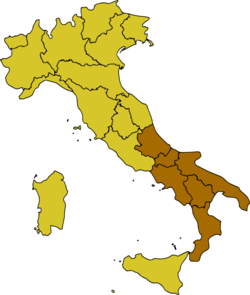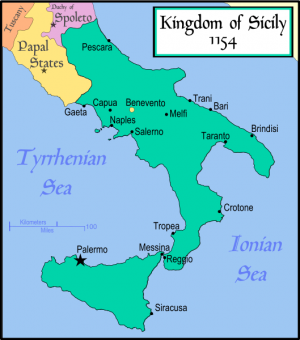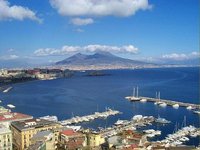Southern Italy

| |
| Southern Italy | |
|---|---|
| Regional statistics | |
| Largest city | Naples |
| Regions of Italy | Apulia, Abruzzo, Basilicata, Calabria, Campania, and Molise. Sicily is sometimes included. |
| Area - Total |
47,504 mi² (123,036 km²) |
| Languages |
Standard Italian (official); Neapolitan, Sicilian, and Southern Italian; minorities of Griko and pockets of Franco-Provençal, Occitan and Arbëresh. |
| Population - Total (2006) - Density |
20,755,621 168.6 people/km² |
| GDP (nom.) - Total - Per capita |
2003 estimates $0.369 trillion (17h) $17,924 (26th) |
| GDP (PPP) - Total - Per capita |
2003 estimates $0.365 trillion (24th) $17,724 (32th) |
Southern Italy (Italian: Italia Meridionale) generally refers to the southern portion of the continental Italian peninsula historically forming the Kingdom of Naples. It encompasses the modern regions of Basilicata, Campania, Calabria, Apulia and Molise, which lie in Italy's south, and Abruzzo which is located in central Italy. Some would also include the most southern parts of Lazio (Sora, Cassino and Gaeta districts), which historically were part of the southern kingdom. Sicily is sometimes included due to its historical political and cultural connections.
The Istituto Nazionale di Statistica (ISTAT) uses the term Southern Italy but excludes Sicily, which it groups with Sardinia as Insular Italy; this is the same grouping used for European parliament elections.
The term Mezzogiorno (Midday) includes southern Italy and Insular Italy (Sicily and Sardegna). The term first came into use in the 18th century and is an Italian rendition of meridies (Latin for 'south', because of the sun's position at midday in the northern hemisphere). "Mezzogiorno" was popularised by Giuseppe Garibaldi and the term came into vogue after Italy's unification. It was sometimes associated with notions of poverty, illiteracy, and crime: stereotypes of the South that often persist to this day.
Geography
Southern Italy forms the lower "boot" of the Italian peninsula, containing the ankle (Abruzzo and Molise and southern Lazio), the toe (Calabria), and the heel (Apulia). Separating the two is the Gulf of Taranto, named after the city of Taranto, which sits at the angle between the heel and the boot itself. It is an arm of the Ionian Sea. The rest of the southern third of the Italian peninsula is studded with smaller gulfs and inlets.
On the eastern coast is the Adriatic Sea, leading into the rest of the Mediterranean through the Strait of Otranto (named after the largest city on the tip of the heel). On the Adriatic, south of the "spur" of the boot, the peninsula of Monte Gargano (Policastro), the Gulf of Salerno, the Gulf of Naples, and the Gulf of Gaeta are each named after a large coastal city. Along the northern coast of the Salernitan gulf, on the south of the Sorrentine peninsula, runs the famous Amalfi Coast. Off the tip of the peninsula there is the world famous isle of Capri.
The climate is classic Mediterranean (Köppen climate classification Csa), except at the highest elevations (Dsa, Dsb) and the semi-arid eastern stretches in Apulia, along the Ionian Sea in Calabria, and the southern stretches of Sicily (BSw).
The largest city of Southern Italy is Naples, a title it has historically maintained for centuries. Bari, Taranto, Reggio Calabria, Foggia and Salerno are the next largest cities in the area. Palermo would be the second largest city if one includes Sicily as part of southern Italy.
History
Main Article Kingdom of Naples|Kingdom of Two Sicilies
Ever since the Greeks colonised Magna Graecia in the eighth and seventh centuries BC, the south of Italy has, in many respects, followed a distinct history from the north. After Pyrrhus of Epirus failed in his attempt to stop the spread of Roman hegemony in 282 BC, the south fell under Roman domination and remained in such a position well into the barbarian invasions (the Gladiator War is a notable suspension of imperial control). It was held by the Byzantine Empire after the fall of Rome in the West and even the Lombards failed to consolidate it, though the centre of the south was theirs from Zotto's conquest in the final quarter of the 6th century. Amalfi, an independent republic from the 7th century until 1075, and to a lesser extent Gaeta, Molfetta, and Trani, rivalled other Italian maritime republics in their domestic prosperity and maritime importance.

From then to the Norman conquest of the 11th century, the south of the peninsula was constantly plunged into wars between Greek, Lombard, and the Caliphate. The Norman conquest of southern Italy completely subjugated the Lombard principalities, and overwhelmed the Byzantines from all but Naples, which ultimately gave in to Roger II in 1127. He raised the south to kingdom status in 1130, calling it the Kingdom of Sicily. The Normans retained harmonious control of their territory, and ran the kingdom of Sicily efficiently. However, it lasted only 64 years before the Holy Roman Emperors long-held designs on the region came to fruition. The Hohenstaufen rule ended in defeat, but the conquering French of Charles of Anjou were themselves forcibly pushed out in the event immortalized as the Sicilian Vespers. Hereafter, until the union in Spain, the kingdom was split between the principalities of Naples on the mainland and of Sicily over the island. The Aragonese rule left its impression on Italy and the Renaissance through such figures as Alfonso the Magnanimous and the Borgia clan. With the unification of the crowns of Castile and Aragon in the late 15th century, southern Italy and Sicily ceased to have a local monarch and were ruled by viceroys appointed by the Spanish crown.
The region remained a part of Spain until the War of the Spanish Succession, when Duke Victor Amadeus II of Sardinia took Sicily. It was soon exchanged with Austria for Sardinia. It became an independent kingdom for Charles of Bourbon and experienced a period of enlightenment with a local, flourishing royal court. In 1798 the French revolutionaries captured southern Italy and created the short-lived Parthenopaean Republic. Eventually, France created the Kingdom of Naples for the benefit of Napoleon's marshal Joachim Murat. An object of irredentism and the Risorgimento, the land was conquered by Giuseppe Garibaldi and the Redshirts in 1861 and, with the north, formed the modern state of Italy.
Garibaldi’s Redshirts were supported by nearly all southern Italians, who wanted the ideals of Unification to improve their still feudal regions. However, to those supporting the Bourbons the "northern regime" of Victor Emanuel II was "a hostile invasion which looted the treasury of the Kingdom of the Two Sicilies, devastated the heavily protected local industries, and reduced Naples from the fourth largest city in Europe and the capital of a kingdom to a provincial town".
The transition to a united Kingdom of Italy was not smooth for the South. The Southern economy was much more agrarian and feudal than the industrial northern economy (with few notable exceptions: Salerno, "the Manchester of the two Sicilies", could count in 1877 something like 10,000 textile workers, more than twice the textile labour of widely-known productive centers like Turin). Poverty and organized crime, though were persistent problems in Southern Italy as well. Because of this, the South experienced great economic difficulties resulting in massive emigration leading to a worldwide Southern Italian diaspora. Many natives also relocated to the industrial cities in northern Italy, such as Genoa, Milan and Turin. A relative process of industrialization has developed in some areas of the "Mezzogiorno" after World War II.
Today, the South remains considerably less economically developed than the North, which enjoyed an "economic miracle" in the fifties and sixties. Some Southern Italian secession movements have developed, but have gained little, if any, significant influence.
North-South Divide
Although in recent history southern Italy has been less affluent than the North, in the past (mainly before the Renaissance) southern Italy was often a prosperous and advanced area, culturally and economically more wealthy than northern or central Italy, and a leader in European cultural and political affairs.
The Norman Kingdom of Sicily was prosperous and politically powerful, becoming one of the wealthiest states in all of Europe.
In the 11th and 12th centuries, Sicily and the Kingdom of Naples played a major role in European affairs and exhibited many signs of prosperity. Some historians say, however, that by the middle of the 13th century, due to fiscal policies that prevented the growth of a strong merchant class, the region became economically backward compared to the northern Italian states. Unlike the rest of Italy, which experienced the rise of many small, independent and prosperous city states, all enterprise in the comparatively large kingdom centred on the capital city of Naples. The outlying areas, cursed with generally poor agricultural conditions, fell further behind. Sicily's trade fell primarily under Catalan control and by the 14th C. finances of the kingdom fell primarily into Tuscan hands. In spite of economic repression, Southern Italy did experience periods of cultural flowering. With the Spanish conquest, however, the kingdom continued to be repressed and exploited by foreign rule until the late 18th century and even when Bourbon rule meant a native court and a time of enlightenment for some sectors of the society.
According to some historians, during the time of the Bourbons the area around Naples became relatively highly productive. It was the first place in all of Italy to build a railway, even if it was for royal (not commercial) use only, and the local manufacturing base was growing. Following the unification with the rest of Italian peninsula in 1861, factory technology (which the Kingdom of the Two Sicilies had gained from the British) was taken away to Piedmont, Lombardy and Liguria. One should not be led to think, however, that prior to the Risorgimento Southern regions were especially prosperous, only to be pillaged and ruined by greedy Notherners.
South of Rome, there had always been deeply depressed areas for centuries. Garibaldi managed to overcome the fifty-thousand-strong Borbonic army with just 1000 volunteers exclusively thanks to the uprising of impoverished and oppressed peasants living in a serf-like condition in the Sicilian fiefs. Sicily was in fact still a semi-feudal society dominated by all-powerful barons who exercised near-absolute rights over their subjects. Sicilian landlords continued to operate their own judicial courts until de jure 1812 and de facto 1860. The highly-profitable sulfur-mining industry was virtually the only significant industrial activity developed on the island. Socio-economic conditions were generally better on the continent, though still well below the Northern Italian states average, which was below the European average on its own.
After the 1860 unification, there was no improvement. Governmental neglect and local aversion to change by the feudal nobility assured that things could only get worse.
Southern Italy experienced a huge demographic expansion due to the improved sanitary conditions set up by the Savoia regime, which provoked mass emigration especially between 1892 and 1921. Corruption was such a large problem that PM Giovanni Giolitti once conceded that places existed "where the law does not operate at all". One study released in 1910 examined tax rates in north, central and southern Italy indicated that northern Italy with 48% of the nation's wealth paid 40% of the nation's taxes, while the south with 27% of the nation's wealth paid 32% of the nation's taxes. Several natural disasters (earthquakes and landslides) also occurred during this period, often killing hundreds of people at a time. Giolitti's administration poor response to a major earthquake in Messina in 1908 was blamed for the high number of casualties. The management of the aftermath of the Messina earthquake infuriated Southern Italians who claimed that Giolitti favoured the rich North over them.
After the rise of Fascism, PM Benito Mussolini set himself the task of defeating the already powerful criminal organizations flowering in the South. The origin of the Sicilian mafia is unclear. It was a criminal phenomenon already present at the beginning of the XIX century, stemming probably from the disaffected former petty chiefs and soldiery at the service of the feudal lords. The fascist dicatator sent his own prosecutor, Cesare Mori, invested with absolute powers. Mori suspended all constitutional warranties and used the army in an attempt to overcome the local population's omertà and smash the mafia once and for good. He was initially very successful. However, when he began to uncover the profound, hidden links and overlapping between the local political elite, fascist hierarchy and mafia, he was forced to stop and hastily recalled to Rome, where he was given a Senate seat to keep him quiet.
Economically, Fascist policy aimed at the creation of an Italian empire and Southern Italian ports were strategic for all commerce towards the colonies. Naples enjoyed a demographic and economic rebirth mainly thanks to the interest of the King Victor Emmanuel III, who was born there.
During the 1950s, the regional policy the Cassa per il Mezzogiorno was set up to help raise the living standards in the South to those of the North. The Cassa aimed to do this in two ways: by land reforms creating 120,000 new small farms, and through the "Growth Pole Strategy" whereby 60% of all government investment would go to the South, thus boosting the Southern economy by attracting new capital, stimulating local firms, and providing employment. As a result the South became increasingly subsidized and dependent, incapable of generating growth itself.
An American scholar, Edward C. Banfield wrote during this period his major work The Moral Basis of a Backward Society, where he expressed his view that the South economic misery was due primarily to its population's amoral familism, i.e. to their inability to conceive the modern concept of communitary common good, beyond direct tribal-like family interests. Banfield's book is still often cited in academic circles and sometimes in the political discourse.
Today, in spite of increased affluence and a much improved economy, the regional disparities persist. Southern Italy continues to be the least prosperous area of Italy, and Western Europe. Problems still include corruption, organized crime and relatively high unemployment. Southern Italy includes 37% of Italy's population, occupies 40% of its land area, but only produces 24% of its gross domestic product. This does not, however, include the large underground black economy, i.e. economic activities unreported so as not to pay taxes and pensions, reported to be as high as 30% of GDP.[1] If the economy of some Southern regions (i.e. Campania and Apulia) were considered with this undergrounf activities (economia sommersa), the GDP would probably be near to that of central Italy.
After being weakened during the 1920s and 1930s, organised crime was given total freedom by the United States during the occupation of Sicily, because controlling the territory was de facto impossibile without their cooperation. After WWII, the Democrazia Cristiana party who governed Italy for almost 50 years, from 1948 to 1992, sought a pragmatic electoral pact with the mafia, an anti-communist real-politik strategy (the Communist Party of Italy was the biggest among Western nations) that made the mafia unprecedentedly rich, and the political elite unprecedentedly corrupted. Things deteriorated tragically during the early 1990s, when the mafia sought a direct confrontation with the Italian state, killing the two top anti-mafia judges, Giovanni Falcone and Paolo Borsellino, and attacking targets even outside Sicily, in Rome, Florence and Milan. The state fought back seriously for the first time, because the entire political class was under judicial investigation and public scrutiny in the aftermath of the greatest corruption scandal of European history, Tangentopoli. Now the mafia is still alive and well, but it has relinquished a direct confrontational strategy that would inevitably force politicians to react. It remains quiet doing great business (prostitution, extortion, illigal waste management, and overall drug trafficking), with the direct or indirect complicity of the political system.
However, even though the standard of living is still below that of northern and central Italy, there are districts of substantial economic solidness. On the whole, Southern Italy's per capita income has improved to the point where it is nearing the 27-state European Union median.
Culture
The regions of Southern Italy were exposed to some different historical influences than the rest of the peninsula, starting most notably with Greek colonization. Greek influence in the South was dominant until Latinization was completed by the time of the Roman Principate. Greek influences returned by the late Roman Empire, especially following the reconquests of Justinian and the Byzantine Empire.
Sicily, a cultural crossroads throughout the Middle Ages, was captured by Muslims and turned into an Emirate for a period, and via Sicily elements of progressive Islamic culture, architecture and science were introduced to Italy and Europe. The rest of the mainland was subject to a struggle of power among the Byzantines, Lombards, and Franks. In addition, the Venetians established outposts as trade with Byzantium and the Near East increased.
Until the Norman conquests of the 11th and 12th centuries much of the South followed Eastern rite (Greek) Christianity. The Normans and other northern rulers of the Middle Ages significantly impacted the architecture, religion and high culture of the region. Later, Southern Italy was subjected to rule by the new European nation states, first Aragon, then Spain and Austria. The Spanish had a major impact on the culture of the South, having ruled it for over three centuries.
In recent years, Southern Italy has experienced a revival of its traditions and music, such as Neapolitan song and the Tarantella.
See also
Related categories
- Regions of Italy
- Northern Italy
- Northeast Italy
- Northwest Italy
- Central Italy
- Southern Italy
- Insular Italy
- Groups of regions of Italy
- List of islands of Italy
- ↑ Cite error: Invalid
<ref>tag; no text was provided for refs namedautogenerated3

